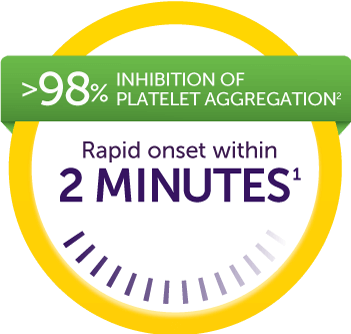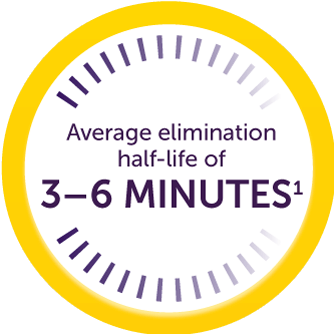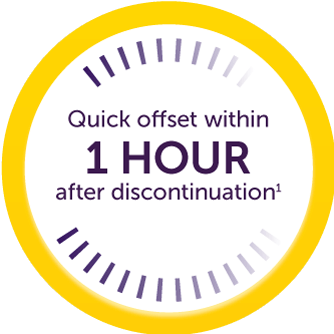KENGREAL® (cangrelor) Pharmacology
Rapid platelet inhibition with quick offset1

- >98% inhibition of platelet aggregation in whole blood impedance aggregometry2
- IV administration1
- Bolus followed by infusion
- Direct-acting1


- Clearance independent of renal or hepatic function1
How KENGREAL works1
KENGREAL is a direct P2Y12 platelet receptor inhibitor that blocks ADP-induced platelet activation and aggregation. KENGREAL binds selectively and reversibly to the P2Y12 receptor to prevent further signaling and platelet activation.
Consistent pharmacokinetics1
- Not influenced by age, sex, renal function, hepatic function, or patient presentation
- KENGREAL is contraindicated in patients with significant active bleeding
KENGREAL inhibition of thrombus formation
in vivo
In this 30-second video, see the effect of KENGREAL on the thrombotic response to laser-induced injury in the mouse cremaster muscle arteriole.2,3
KENGREAL inhibition of thrombus formation in vivo
In this 30-second video, see the effect of KENGREAL on the thrombotic response to laser-induced injury in the mouse cremaster muscle arteriole.3,4
Information featured here includes in vivo data, the clinical significance of which has not been established.
KENGREAL is specifically designed as an adjunct to PCI1,4
KENGREAL rapidly inhibits platelet aggregation within 2 minutes and provides quick offset within 1 hour of discontinuation.
KENGREAL pharmacology1,4
Phase I study in healthy volunteers (n=9); dose: 30 mcg/kg IV bolus + 4 mcg/kg/min IV infusion. KENGREAL blood levels and platelet activity were assessed over 150 minutes by whole blood impedance aggregometry in response to 20 μM of ADP.4
Infusion should be continued for at least 2 hours or the duration of the procedure, whichever is longer.1
Platelet function returns to baseline within 1 hour
Because of its offset within 1 hour,1 patients who need CABG or surgery after PCI can proceed soon after KENGREAL discontinuation.
P2Y12 inhibitors come with different pharmacological profiles
There are several clinical options available for inhibiting platelets during PCI. Each has a unique pharmacological profile.
P2Y12 inhibitor options
Clinical studies have not established that IV administration or pharmacological characteristics result in superior efficacy or safety based on clinically relevant endpoints.
PD=pharmacodynamic; CPTP=cyclopentyl-triazolopyrimidine.
*First time point at which inhibition of platelet aggregation was measured.
†Based on 75 mg daily dose, when platelet inhibition reaches steady state. Time to maximal effect for a loading dose is not provided in the Prescribing Information.
‡40–60% refers to average inhibition at steady state.
§Active metabolite of ticagrelor has a half-life of 9 hours.
‖Active metabolite of clopidogrel has a half-life of 30 minutes.
Important Safety Information
KENGREAL® (cangrelor) for Injection is contraindicated in patients with significant active bleeding.
KENGREAL® is contraindicated in patients with known hypersensitivity (e.g., anaphylaxis) to cangrelor or any component of the product.
Drugs that inhibit platelet P2Y12 function, including KENGREAL®, increase the risk of bleeding. In CHAMPION PHOENIX, bleeding events of all severities were more common with KENGREAL® than with clopidogrel. Bleeding complications with KENGREAL® were consistent across a variety of clinically important subgroups. Once KENGREAL® is discontinued, there is no antiplatelet effect after an hour.
The most common adverse reaction is bleeding.
Indication
KENGREAL® (cangrelor) for Injection is a P2Y12 platelet inhibitor indicated as an adjunct to percutaneous coronary intervention (PCI) to reduce the risk of periprocedural myocardial infarction (MI), repeat coronary revascularization, and stent thrombosis (ST) in patients who have not been treated with a P2Y12 platelet inhibitor and are not being given a glycoprotein IIb/IIIa inhibitor.
